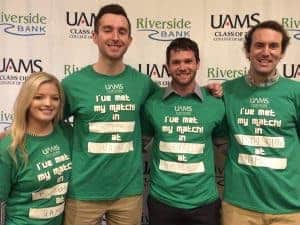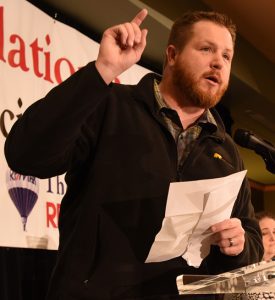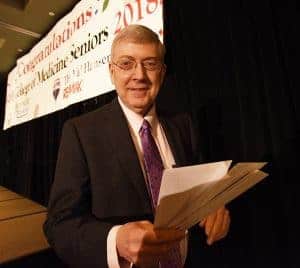Tears came in all shapes and sizes at Match Day 2018 – tears of joy, tears of relief and tears from proud families.
“I’m going to cry,” College of Medicine senior class President Grant Cagle said prophetically while welcoming the audience, made up of the 155 seniors who participated in the match, their families and mentors and staff from UAMS in a packed room March 16 at the Embassy Suites in Little Rock.
A short time later, he ripped open a sealed envelope to reveal the location and specialty for his residency: internal medicine at Rhode Island Hospital/Brown University in Providence. Almost inaudible through tears, he assured the crowd that it was his dream match, and the audience erupted to share his joy.

Student after student came to the podium, each with their own version of Cagle’s story, including the years of work, high expectations and support from others along the way. Many used their time at the mic to give thanks.
“It takes a team just for one medical student to graduate,” Cagle said.
Each year Match Day starts at 11 a.m. Central Time, with senior medical students all over the nation simultaneously opening envelopes to reveal their “match” – or where they have been accepted to continue their training in a specialty residency for the next three to seven years.
For some, the tears came later, maybe as they hugged their proud mothers and fathers waiting on the sidelines, or while hugging other members of their class – peers who can truly understand everything that has led up to this day.
Tess Coker and Alex Croft got a little misty-eyed as they looked back to that first day of school when they met. Soon after, they started dating. They had each other to lean on throughout the highs and lows of med school, and the match process for couples is especially daunting.
Match Day is conducted by the National Resident Matching Program (NRMP). Students in their fourth year apply to programs, interview and then send a ranked list to the NRMP. Residency programs also submit a list of preferred candidates, and an NRMP computer, using an algorithm, reconciles the lists as best as possible.

Couples face the additional challenge of trying to match in the same geographical area, while considering each other’s career goals with regard to specialty and the prestige of the program. There is a “couple match” option through the NRMP that tries to factor in geography, but still, it’s tough. One of the students who didn’t match this year was a member of a couple who was not looking for alternatives in order to stay close to a partner.
“We both knew on Monday that we had matched somewhere, but you don’t know exactly where, and even with couple matching you still have to list some apart, and couple matching in general just limits your options,” Croft said. “We were both super nervous coming into this.”
Coker’s envelope revealed she had matched in pediatrics; Croft matched in emergency medicine – both at Indiana University School of Medicine in Indianapolis.
“We couldn’t be more happy,” Croft said.
Cody McLeod of Arkadelphia, on the other hand, said selecting his top rank was easy. At the mic, he announced his match – orthopaedic surgery at UAMS – with a bit of punch in his voice, and the crowd cheered in response. McLeod’s father is an orthopaedic surgeon in Arkadelphia and he envisions a similar future for himself.

“I’ve had so many great mentors in the ortho department,” McLeod said. “It was a no-brainer for me to stay in that program. They’re doing exciting things right now, and I’m glad I’m going to get to be a part of it.”
McLeod said that in addition to his mentors, support from his wife has been key, and he’s glad he will have the support of some familiar faces as part of his residency. Derrick Henry, Timothy Hereford and Sean Parham also matched in the department.
Several students also matched in family medicine at the UAMS Regional Center in Pine Bluff, including Robert Ferguson of Booneville, who said he hopes the program will take him one step closer to his goal of becoming the rural Arkansas family doctor he aims to be.
“It’s what I’ve always wanted to be,” Ferguson said. “When I was growing up, the doctor you saw in the doctor’s office was the same one you saw in the hospital, it was the same person providing you with almost all of your care. That was my idea of what a doctor was.”
Similarly, Julie Sherrill, who grew up in Dumas and attended the University of Arkansas at Fayetteville for her undergraduate degree, matched in pediatrics at UAMS just as she hoped.
“I grew up in rural southeast Arkansas, where health care is limited and doctors are hard to find,” Sherrill said. “I want to be a primary care provider for children and adults in a small, rural community. Arkansas is my home state and I really would like to use my training to care for the people here.”
This year, 51 percent of the UAMS students matched in primary care – internal medicine, pediatrics, family medicine or obstetrics/gynecology. With an in-state tuition and fees for the 2017-2018 academic year of $32,378, many Arkansans pursuing careers in medicine see the value in a quality education at that price and chose to complete medical school at UAMS close to home.
One of UAMS’ goals is to inspire doctors to stay in Arkansas for their careers, particularly those in family medicine.
The program ranks third in the nation at retaining medical school and residency program graduates in the state. More than two thirds of Arkansas’ 75 counties include federally designated Primary Care Health Professional Shortage Areas. For five out of the last nine years, UAMS has ranked among the top 10 Doctor of Medicine programs in the nation for the number of graduates who chose family medicine.

Richard Wheeler, M.D., executive associate dean for academic affairs in the College of Medicine, started keeping statistics related to Match Day in 2005. Although there were many tears at this year’s Match Day, thankfully, few were related to students not matching at all. This year, five students did not match in the first round.
“One of the problems that students have now is the number of students graduating from medical school has increased,” Wheeler said. “The number of residencies that are opening have not kept up with that. Last year there were over 600 students in the United States who didn’t get anything at all … and that’s horrible.”
Wheeler said UAMS is working with other hospitals and programs in the state to open additional residency slots in an effort to address this issue, and every year the staff continues to help students find positions even if they didn’t match in the first round.
“We’d like to have everybody match,” Wheeler said.
The NRMP billed the 2018 Main Residency Match as the largest in history, exceeding the more than 43,000 applicants who registered for the 2017 Match and the more than 31,000 positions offered by residency programs across the nation last year.

